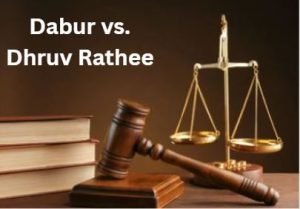Introduction
Dabur claimed that Dhruv Rathee’s video unfairly compared carbonated drinks with ready-to-serve (RTS) fruit beverages, causing a generic disparagement of all packaged drinking fruit juices. Dabur also alleged that the video specifically targeted its Real fruit juices by using partially blurred Real logos and promotional advertising clips.
The court recognized that while dissemination of information through any medium is a reality today, it should be legal. Freedom of speech and expression under Article 19(1)(a) is limited through Article 19(2). In the video, an advertisement was shown that was aired by Real and its product was blurred, leading the court to conclude that any consumer would assume the product shown in the video belongs to Dabur.
The court also invoked Section 29(9) of the Trademarks Act, which deals with infringement of a mark by its spoken use or visual representation, to hold that the unauthorized use of packaging, label, and logo of the Real product in the video violated trademark and copyright protection.
The Delhi High Court interpreted the aforementioned section in the case of Hamdard National Foundation v. Hussain Dalal. The court held that the spoken words must either be a misstatement causing confusion and deception, which is the essence of the passing off action, or they should cause infringement by diluting the distinctive character and reputation of the trademark, whether intentional or unintentional. Therefore, the intent to defame or tarnish the mark’s reputation is irrelevant, and what matters is whether the actions alleged are causing confusion and deception.
Rathee, in the current scenario, has presented his views substantiated by factual evidence, citing the ingredient table of “Real” fruit juice and drawing conclusions about its impact on health. While a separate court delivered the judgment in this case, its persuasive value is limited, and the Calcutta High Court’s order appears to lack the crucial elements of fairness and justice. Firstly, the court failed to investigate whether the statements and assertions made in the video were accurate or inaccurate, and neglected to differentiate between opinions and facts. Such an investigation is necessary since opinions cannot be the foundation for claims of defamation or disparagement. Secondly, the court did not fulfil the requirement of the section by identifying the unique feature that was recognisable in the video. Thirdly, even if speech can violate a trademark, the court did not specify the specific parts of the video in which Rathee purportedly infringed the trademark.
The court in the present case did not rely on section 30(1) of the Trademarks Act, which, when read with section 29(9), may prima facie establish a case of disparagement against Rathee. However, it is important to note that the impugned video does not mention the words “Dabur” or “Real”, and Dabur itself admitted that the “Real” mark was blurred in the video. Furthermore, freedom of speech is a fundamental right, and creative freedom is an integral part of it. Therefore, the court must balance the petitioner’s right to protect their trademark and the respondent’s right to express their opinions. In generic disparagement cases, a greater degree of leeway should be provided to creative freedom, even if a prima facie case of disparagement can be made.
In the present case, the court has discussed the three requirements for granting an interim injunction, but it does not provide sufficient reasoning as to why the balance of convenience favours the petitioners or how the video causes irreparable damage. All three requirements must be met to grant an interim injunction, which does not seem to be the case here. The video did not directly refer to the product and the advertisement shown in the video was blurred, which weakens the argument for granting an injunction. Even if the court were to grant an interim injunction, it should have been limited to removing the specific advertisement only.
It is noteworthy that Dabur specifically chose to approach the Calcutta HC to file their case despite having the option to approach any HC. This is because the jurisprudence surrounding trademarks in Calcutta is different from that in other HCs such as Bombay or Delhi. This highlights the advantage that large corporations have over smaller businesses that may find it challenging to engage in similar legal battles, especially if they are located far from the court.
Furthermore, it is interesting to observe that Dabur decided to pursue a trademark disparagement case rather than a defamation case. In defamation cases, truth is generally a defense against liability, and the focus would have been on whether Dhruv Rathee was speaking the truth or not. However, in the present case, the inquiry is centered around the interpretation of the Trademark Act. It should be noted that in some other cases, corporations have pursued both defamation and trademark-related claims.
Conclusion
As highlighted in the article, the court’s ruling and subsequent orders present issues. It is a missed opportunity to clarify the applicability of Section 29 in non-advertisement videos since most of the jurisprudence has developed around advertisements. The application of Section 29(9) is also unclear, and the court should consider the fundamental right of freedom of speech and expression and provide latitude to content creators and others in such cases.
Author: Tanya Saraswat, in case of any queries please contact/write back to us via email to chhavi@khuranaandkhurana.com or at Khurana & Khurana, Advocates and IP Attorney.
References
- https://spicyip.com/2023/03/trademark-disparagement-free-speech-and-bullying-the-case-of-dabur-v-dhruv-rathee.html
- https://indiankanoon.org/doc/77092668/




